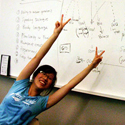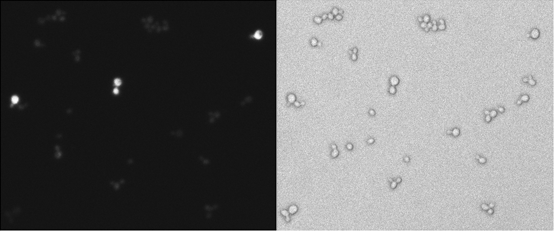Team:British Columbia/Notebook/Week 11
From 2011.igem.org
(→alpha-Pinene) |
(→alpha-Pinene) |
||
| Line 28: | Line 28: | ||
==alpha-Pinene== | ==alpha-Pinene== | ||
| - | Joe got his primers and successfully introduced all the necessary cuts sites ( NcoI and SpeI for the yeast plasmids; EcoRI and PstI for biobricks) for insertion into biobrick and yeast plasmids, GAL and GPD. Gel electrophoresis results shows a band around (1.8-2.0kb long), which verifies that his PCR was successful. He then digested all his PCR producted with the appropriate restriction enzymes and ligated to the appropriate plasmids (pSB1C3 for Biobrick creation, pAG415Galccdb and pAG415GPDccdb for yeast plasmid) He then transformed the ligations into DH5-alpha cells and plated into the appropriate plates (yeast plasmids contain ampicillin resistance, while psB1C3 plasmids contain chloramphenicol resistance). Colonies grew for alpha-pinene synthase under the GAL promoter while only one colony grew for alpha-pinene synthase under the GPD promoter. Also colonies grew for alpha-pinene synthase in the psB1C3 plasmid. The colonies for each construct were then cultured with its plasmids isolation through mini-prep purification. PCR with the original primers designed for biobrick and yeast plasmid were performed to identify whether our alpha-pinene synthase is inserted into each of the plasmid. The PCR reactions proved positive, verifying that the plasmids contain alpha-pinene synthase. The yeast plasmids containing the alpha-pinene were later transformed into yeast | + | Joe got his primers and successfully introduced all the necessary cuts sites ( NcoI and SpeI for the yeast plasmids; EcoRI and PstI for biobricks) for insertion into biobrick and yeast plasmids, GAL and GPD. Gel electrophoresis results shows a band around (1.8-2.0kb long), which verifies that his PCR was successful. He then digested all his PCR producted with the appropriate restriction enzymes and ligated to the appropriate plasmids (pSB1C3 for Biobrick creation, pAG415Galccdb and pAG415GPDccdb for yeast plasmid) He then transformed the ligations into DH5-alpha cells and plated into the appropriate plates (yeast plasmids contain ampicillin resistance, while psB1C3 plasmids contain chloramphenicol resistance). Colonies grew for alpha-pinene synthase under the GAL promoter while only one colony grew for alpha-pinene synthase under the GPD promoter. Also colonies grew for alpha-pinene synthase in the psB1C3 plasmid. The colonies for each construct were then cultured with its plasmids isolation through mini-prep purification. PCR with the original primers designed for biobrick and yeast plasmid were performed to identify whether our alpha-pinene synthase is inserted into each of the plasmid. The PCR reactions proved positive, verifying that the plasmids contain alpha-pinene synthase. The yeast plasmids containing the alpha-pinene were later |
| + | <html><b><a href="https://2011.igem.org/Team:British_Columbia/Protocols/Yeast"> transformed into yeast </b></a></html> | ||
==Characterization: Limonene Synthase (LIMS1) - Part BBa_I742110== | ==Characterization: Limonene Synthase (LIMS1) - Part BBa_I742110== | ||
Revision as of 01:14, 29 September 2011

 |
 |
 |
 |
 |
Contents |
Lab Meeting - August 15
At the meeting today, we briefly talked about getting more sponsors. We also began discussing the design for the team t-shirts as well as potential activities for Imagine Day (This is a one day orientation mainly targeted towards first years; however, there is a main event in the afternoon where clubs such as ourselves can set up booths to inform the new and returning students of the resources and extracurricular activities that are available to them).
1,8-cineole
There are colonies on the yeast plates! They remained very small even on the fifth day after plating, but the fact that they were present means that Jacob can proceed with the GC-MS.
Only the synthase genes that had undergone SDM were used to transform the yeast so far. In order to check that there was no change in the expression due to the silent mutations that Jacob introduced with the SDM, he prepared shuttle vectors to get the original synthase into yeast.
The pgxe-cineole biobrick seems to be correct, so Jacob plans to make a glycerol stock of it, as well as submit the biobrick to the parts registry. Hurrah! We have a part!
The pg-cineole biobrick has been unsuccessful up to this point, but another round of PCR to attach the biobrick suffix and prefix was quite successful. Previously, Jacob was using the annealing temperature of just where the primer would bind to the original synthase, but it was pointed out that in a PCR reaction, all subsequent same-direction amplifications after the first one attach fully, raising the Tm. Using the new Tm, the PCR worked far better. The ligation and transformation were also successes.
beta-Pinene
Still working on getting the original synthase onto a yeast plasmid containing GPD promoter, she re-dos the ligations using a 6:1 ratio instead of 3:1. She then transforms the product into E.coli. Vicki also digests and ligates the original synthase and the yeast plasmid containing GAL promoter (ONL) together and transforms that into E.coli. She got colonies for the original synthase with the GPD promoter in yeast (OND), but nothing for the other transformation (ONL). Instead of cPCR, Vicki set up an overnight culture for miniprep to verify the OND plasmid. She miniprepped the next day and verified that it was the correct plasmid by digesting with the appropriate enzymes (NotI and XhoI) and running the digested samples on a gel. Success! Vicki proceeded to transform this plasmid (OND) into wildtype yeast, and got colonies! Hurrah! Because Vicki is leaving for Montreal soon, she will be passing the remainder of her work to Gurpal. Thanks Gurpal! In terms of the ONL, Vicki re-dos the ligations, using a 6:1 ratio instead of 3:1, and transformed with 7uL of ligation mix. She got colonies the next day (YAY!) and proceeded to set up an overnight culture for miniprepping. After she miniprepped the plasmid (ONL), she verified it by digesting it with the appropriate enzymes (NotI and XhoI) and running the digested samples on a gel. Success! This plasmid (ONL) was then transformed into wildtype yeast. Currently growing in the incubator...
Vicki continues the GC-MS preparation for the samples previously outlined (last week) - see the protocol here! However, Vicki and Marianne received their beta-pinene GC-MS results and discovered that their yeast was not producing any beta-pinene!!!! Oh no!! Hence, they discarded the samples they were preparing for the next GC-MS run. Now the troubleshooting begins...
Marianne PCRed the biobrick beta-pinene synthase gene to send off for sequencing. The result shows that the sequence is correct and is good for sending off to iGEM!
alpha-Pinene
Joe got his primers and successfully introduced all the necessary cuts sites ( NcoI and SpeI for the yeast plasmids; EcoRI and PstI for biobricks) for insertion into biobrick and yeast plasmids, GAL and GPD. Gel electrophoresis results shows a band around (1.8-2.0kb long), which verifies that his PCR was successful. He then digested all his PCR producted with the appropriate restriction enzymes and ligated to the appropriate plasmids (pSB1C3 for Biobrick creation, pAG415Galccdb and pAG415GPDccdb for yeast plasmid) He then transformed the ligations into DH5-alpha cells and plated into the appropriate plates (yeast plasmids contain ampicillin resistance, while psB1C3 plasmids contain chloramphenicol resistance). Colonies grew for alpha-pinene synthase under the GAL promoter while only one colony grew for alpha-pinene synthase under the GPD promoter. Also colonies grew for alpha-pinene synthase in the psB1C3 plasmid. The colonies for each construct were then cultured with its plasmids isolation through mini-prep purification. PCR with the original primers designed for biobrick and yeast plasmid were performed to identify whether our alpha-pinene synthase is inserted into each of the plasmid. The PCR reactions proved positive, verifying that the plasmids contain alpha-pinene synthase. The yeast plasmids containing the alpha-pinene were later transformed into yeast
Characterization: Limonene Synthase (LIMS1) - Part BBa_I742110
Vicki digested and ligated following samples:
- limonene synthase + yeast plasmid with GPD promoter = LD
- limonene synthase + yeast plasmid with GAL promoter = LL
She then transformed the products into E.coli cells. Waiting for results... She got colonies for LL but not for LD. For LL, she grew and overnight culture for miniprepping. The next day, Vicki miniprepped the sample and digested it with NotI and XhoI, and ran it on a gel to verify. Success! This was transformed into wildtype yeast. And 3 days later, there were colonies! For LD, she re-dos the ligations using a 6:1 ratio instead of 3:1 and transformed it into E.coli. There were still no colonies the next day... What to do now...
Vicki will need to pass on the remainder of the work to Gurpal as she is leaving for Montreal in a few days! Again, thanks Gurpal!
GC-MS Preparation for 1,8 Cineole
Gurpal just completed a summer course the day before and was given a lot of wet lab work to finish for other people. Challenge accepted.
First, Gurpal and Vicki prepared the following samples for GC-MS analysis:
- Pgxe-Gal (this is the Pgxe-Cin gene + GAL promoter that should yield 1,8 cineole monoterpenes)
- Pgxe-Galm (this is the media associated with the lysed samples from the above sample)
- Pgxe-GPD (this is the Pgxe-Cin gene + GPD promoter that should yield 1,8 cineole monoterpenes)
- Pgxe-GPDm (this is the media associated with the lysed samples from the above sample)
The samples were stored in the -20°C freezer.
They were also going to prepare samples for PgnGAL and PgnGALm but decided not to.
Characterization: GPD-GFP
We looked at the expression of GFP as regulated by the yeast GPD promoter under a fluorescence microscope...
We will be submitting the GPD promoter as a new Biobrick part and also use it as a standard of comparison for the GAL promoter already in the Parts Registry.
Team Bonding
Today we got together and took our first whole team photos. Check out the one on our team page.



 "
"

















